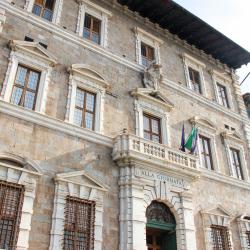Palazzo Lanfreducci, called ‘Alla Giornata’

Now the home of Pisa University Chancellorship, this is one of the most interesting early 18th century buildings in Pisa. It was designed by Cosimo Pugliani, a Florentine architect connected to the Court who designed many adaptations in Pisa. Work began in 1607 by order of Francesco Lanfreducci, knight of Malta, on his return from long imprisonment in Algeria.
The facade in marble and verrucano stone is in the Mannerist style according to the Classical and late Renaissance taste: five windows on three floors and a flight of steps leading to the rusticated doorway with the words “Alla Giornata” carved on the lintel, a balcony above with a French window surmounted by the family coat of arms with lion rampant. A chain with three rings hangs below the lintel.
Several explanations have been suggested for the meaning of the words: a vow, a memento of his condition as a slave, the Epicurean carpe diem or a promise? These words appear on all Lanfreducci properties in Pisa, at Noce and also on Malta. In the 16th century, a “giornata” was a military action – the decisive battle between armies, a pitched battle, the moment of glory: the words are there to remind passers-by of knightly ideals, and were written by a knight who all his life fought disloyal enemies, skillful in using the stiletto but incapable of open combat on the battlefield. It is thought that the three rings of the chain allude to Boccaccio’s novella where they represent the three monotheistic religions, none of which can boast of holding more truth than the others In the 18th century it was frescoed by G.B. Tempesti.
Behind the palazzo is the Lanfreducci casa-torre: built in two stages, in the 12th and 14th centuries, the first in verrucana stone and the later in brick.
